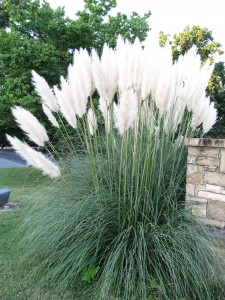Many areas in the mid-South and northeast U.S. (USDA hardiness zones 6 and 7a) learned a hard lesson in the harsh cold winter of 2013-14. Over the past decade gardeners had been lulled into zone bending, insisting on planting species from a warmer zone. One of them was pampas grass (Cortaderia selloana). Very few clumps survived here in the Southern Appalachian region (USDA hardiness 6 and 7).
Pampas grass, depending on cultivar, grows 5 to 10 feet tall and 3 to 6 feet wide. It is a clump growing grass that thrives in full sun and medium soil moisture. A one year old clump displays exceptional drought tolerance. Showy plume flowers appear in mid-summer. Pink or white plumes (inflorescences) cultivars are available at most garden centers in the Southeastern U.S.
One of the most cold-hardy pampas grass varieties is dwarf pampas grass (C. selloana ‘Pumila’). Hardy to zone 6, winter snow plus a 2-3 inch layer of loose leaves provides a protective mulch covering before the start of winter.
Referring to ‘Pumilo’ as “dwarf” is misleading as some varieties of pampas grass are even shorter. Its showy silvery-cream plumes can be used in dried flower arrangements. Vegetative green grass portion grow 3 feet tall and wide. Add another 18-36 inches for the silvery white plumes to rise above the green mound.
Pampas grass establishes quickly, usually in one season. Feed and irrigate the first year after planting. One year old plants are very drought tolerant and require little care other than once a year pruning. Wait until late winter or early spring before cutting pampas grass back. Wear protective clothes as the leaves are razor-sharp!
Usually its enormous size, attractiveness, and architecture are good reasons to consider pampas grass. It is often planted as a stand-alone ornamental grass. Placement in front of tall evergreens helps to make it a statuesque landscape focal point.
Point of reference: at some garden centers you will find Hardy Pampas Grass. This grass is a different genus (Eranthus) and is cold hardy in zones 4b and 5.


 Posted in
Posted in 
